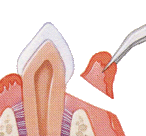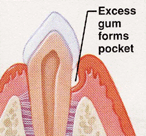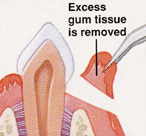
What is Gingivectomy?
Gingivectomy is a type of gum surgery procedure that involves the surgical removal of gum tissue. Gingivectomy was initially used by periodontists as part of gum disease treatment to remove diseased gingival tissue and reduce pockets between the teeth and gums that trap food and bacteria. Today it is also used as a cosmetic dental treatment to improve the aesthetic appearance of the gumline.
When you need a gingivectomy?
Your dentist or periodontist will perform a gingivectomy to:
- Eliminate suprabony pockets or abscesses
- Eliminate gingival overgrowth
- Improve asymmetrical, or unesthetic gingival topography
- Provide access for restorative dentistry
Gum tissue may need to be removed for the following reasons:
- Periodontal pockets (for gum disease treatment) – Gingivectomy is the next step of a periodontal disease treatment when non-surgical treatments such as tooth scaling and root planing or/and antimicrobial treatment have failed to reduce adequately the depth of periodontal pockets. Periodontal pockets can trap food debris and bacteria that can not be removed during brushing and flossing if the depth of the pocket is over 3-4mm. If the bacteria are allowed to grow in the pockets the gum disease will recur. Gingivectomy is used to eliminate the pockets between teeth and gums and allow healthy gum tissue to begin to grow back. It also removes any gingival tissue that has diseased due to the gum infection in order to allow the proper re-attachment of gum on the tooth surface.
- Gingival hyperplasia (for both periodontal and cosmetic treatment) – Certain medications (like anti-seizure or anti-epileptic drugs) cause an excessive growth of gum tissue which expands to cover part of the tooth crown. Gums overgrowth can be cosmetically unappealing having a negative effect in the person’s appearance but also makes it difficult to properly remove dental plaque increasing the risk of periodontal disease. In severe situations, this condition can interfere with chewing and speech. Drugs causing overgrowth of gums include nifedipine, cyclosporine, phenytoin (Dilantin). Some women may also experience gums overgrowth during pregnancy. Gingivectomy removes the excess amount of gum tissue restoring the aesthetic appearance of teeth and allowing better cleaning of teeth surface from dental plaque bacteria.
- Uneven gumline (for cosmetic dental treatment) – In some patients the gum line is not cosmetically perfect with the ratio of tooth crown covered by gums to differ significantly between teeth or not following the contour of the lips. In this case the cosmetic dentist may recommend a minor gingivectomy to correct the gumline irregularities.
- Sub-gingival tooth decay (root caries) - Sometimes a gingivectomy may be required only to allow the dentist to gain access to the root area for performing a dental filling or preparing the area for the attachment of a dental bridge. In this case healthy gum tissue has to be removed but in most cases the loss of tissue is only minor. If the procedure involves also removal of alveolar bone it is referred as crown lengthening.
- Impacted wisdom teeth - When a wisdom tooth has not fully erupted it is completely or partially covered by gum tissue. The gum tissue can get inflamed and infected leading to a condition known as ‘pericoronitis’. A gingivectomy procedure may be recommended to remove the gum flap and expose the widom tooth (operculectomy).
The gingivectomy procedure


Gingivectomy is a surgical procedure performed by a periodontist or an oral surgeon. Before the procedure the patient is advised to follow careful oral hygiene to minimize the amount of dental plaque in the mouth. A professional dental cleaning and, possibly root planing, is almost always recommended to remove bacterial plaque and dental calculus (tartar) from existing pockets prior to the gingivectomy.
The procedure starts by numbing the area to be treated with an injection of local anesthetic so that little or no pain or discomfort is felt during the surgery.
The depth of the periodontal pocket is measured with a periodontal probe. The gums are marked with bleeding points to guide the incisions. Incisions to remove the excess gingival tissue are made apical to bleeding points on a 45 degrees bevel to the root.
In most cases, gingivectomies are performed with a scalpel. Special instruments with angled blades may be used to get around the teeth or cut gums in between the teeth. Electrosurgery units, lasers and/or diamond dental burs may also be used.
After the gingivectomy is completed the periodontist will place a periodontal dressing on the surgical area to promote clot formation and healing, and protect it from infection.
A gingivectomy procedure can take from a few minutes to more than an hour, depending on how much gum tissue has to be removed. If a full mouth treatment is required, the periodontist will usually treat one quadrant of mouth at each appointment.
Post-operative care after a gingivectomy treatment
The periodontist will prescribe pain medication because gingivectomy can be painful after the effect of the anesthesia subsides, especially if the treatment involves several teeth and the extensive removal of gum tissue.
Maintaining good oral hygiene is very important for keeping your gums healthy. For the first days after gum surgery you will be advised to avoid brushing over the surgical area to avoid disturbing the periodontal dressing. A chlorhexidine mouthwash may be prescribed to help in controlling dental plaque. After the dressing is removed you should return to your normal oral hygiene routine using a soft toothbrush.
For the first two weeks of healing period you have to follow a soft diet, avoid spicy and crunchy foods, and drink cool or slightly warm liquids.
Do not smoke. Smoking decreases your ability to fight infections and delays healing.
You will have to visit your periodontist after 7 to 10 days to remove the periodontal dressing and check the healing of gums. Some bleeding when brushing or flossing is normal after the dressing is removed. Gums will start to look normal in three to four weeks, but it can take two to three months for the connective tissue to heal completely.
What are the risks / complications associated with gingivectomy?
No major complications are associated with gingivectomy. Some pain and bleeding can be expected for the first 24 to 48 hours. Pain medication prescribed by the periodontist is normally enough to manage post-surgical pain. Bleeding can be managed by application of pressure on the wound and applying cold packs. The risk of infection or other complications is minimal if you follow the dentist’s instructions. You should call your periodontist if you have:
- bleeding that doesn't stop.
- excessive pain that cannot be managed by pain medication.
- excessive swelling, discharge from the surgical area or any other sign of infection.
- the periodontal dressing becomes loose or is displaced.
After the gingivectomy the remaining gum tissue may look thick or unnaturally shaped around the tooth. Another gum shaping procedure, called gingivoplasty, is commonly perform after a gingivectomy to reshape the remaining gum tissue so that gums fit and look natural around the tooth.
What is the cost of gingivectomy?
The cost of gingivectomy will vary considerably depending on the extent and nature of the damage. The type of procedure also affects the price, with more modern methods using lasers to be more expensive than traditional gingivectomy treatments.
The average cost of a gingivectomy is expected to be around:
- $150 -$300 for one tooth
- $500 -$850 per quadrant (1/4th of the mouth) or
- $2,000 -$4,000 for the whole mouth in case of extensive gum tissue damage
Gingivectomy is a procedure that could be very uncomfortable if several teeth are involved. You can ask for conscious dental sedation but you should expect an additional cost.

